Deployment and Operation of the RAAVEN small Unmanned Aerial System (sUAS) in Support of NOAA Science during ATOMIC
Supported with UAS Program Office funding, a team from the University of Colorado Boulder will deploy the RAAVEN sUAS from Barbados between 19 January and 17 February 2020. Launch and retrieval will occur from the shore at a field and the adjacent beach in Morgan Lewis, Barbados. RAAVEN miniFlux measurements can directly contribute to advancing our scientific understanding relevant to NOAA forecasting efforts across weather and climate scales. Specifically, information on the vertical distribution of



